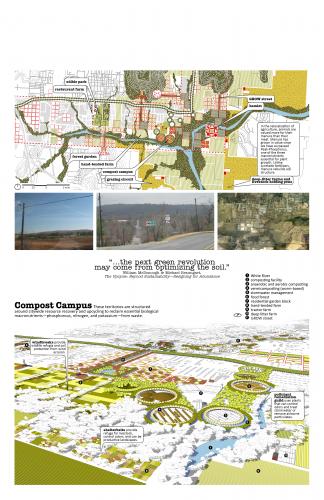
Fayetteville 2030: Food City Scenario
Location: Fayettvile, Arkansas. Urban Areas
Despite being one of America's leading food-producing states, parts of Arkansas suffer from abnormally high hunger rates, with nearly 25% of children deemed “food insecure” compared to the national average of 14.5%. Refusing to accept such a dismal statistic, the University of Arkansas Community Design Center launched a unique project called “Food City” which seeks to build food sustainability for the future in the growing town of Fayetteville. Juror Brent Toderian called Food City a “highly creative, comprehensive and leading- edge ‘thought-piece’ on urban food.”
At its heart, Food City is an introduction to smart farming in urban areas that have a lengthy, indirect or expensive route between industrial agriculture and consumer access. If the switch were made from commodity- based crop yield to small plot intensive farming (permaculture) based upon efficient nutrient cycling and reductions in fossil fuel inputs, yields would have the potential to increase tenfold. The new design proposed here attempts to lasso sprawl spaces into pocket neighborhoods that are clustered around grow areas – community gardens and tree-lined streets that produce fruit and vegetables on a small but crucial scale.
Anticipating a population growth from 75k to nearly 150k in the next two decades, Fayetteville city planners will soon have to address current policies that limit or ban agricultural uses of city land and sale of produce from private gardens. The University of Arkansas’ award winning design poses a convincing plan to turn around the community’s dreary hunger rate and adequately prepare for the future.
In addition to innovative ideas like on-site restaurant gardens, winter farmers’ markets and “edible parks,” the project would drastically restructure the city’s aquaculture. With an entire district of advanced aquaponic systems, modern ponds and hanging gardens functioning as common areas, the city’s fish harvest would be more efficient and aesthetically integrated with the environment.
According to Toderian, “The project went well beyond policy and principle, to connect urban food production with alternative growth scenarios, public space types, and real-world housing.” From farm-to-table arrangements with local institutions to a closed-loop, upcycling waste management system to several greenhouse and other geothermal plans, Food City is an in-depth look at a city’s vibrant potential.
Transect Zone(s): T1 natural, T2 rural, T3 sub-urban, T4 general, T5 center, T6 core.
Status: Proposed
Project or Plan's Scale: Region
Land area (in acres): 35000
Total built area (in sq. ft.):
Total project cost (in local currency):
Retail area (in sq. ft.): 1000000
Office area (in sq. ft.):
Industrial area (in sq. ft.):
Number of hotel units:
Number of residential units (include live/work): 28000
Parks & green space (in acres):
Residential types: Townhouse/rowhouse/maisonette, Live/work.
Project team designers: University of Arkansas Community Design Center
Project team developers: N/A
Previous site status: Undeveloped greenfield
Starting/Ending date of construction/implementation: -


